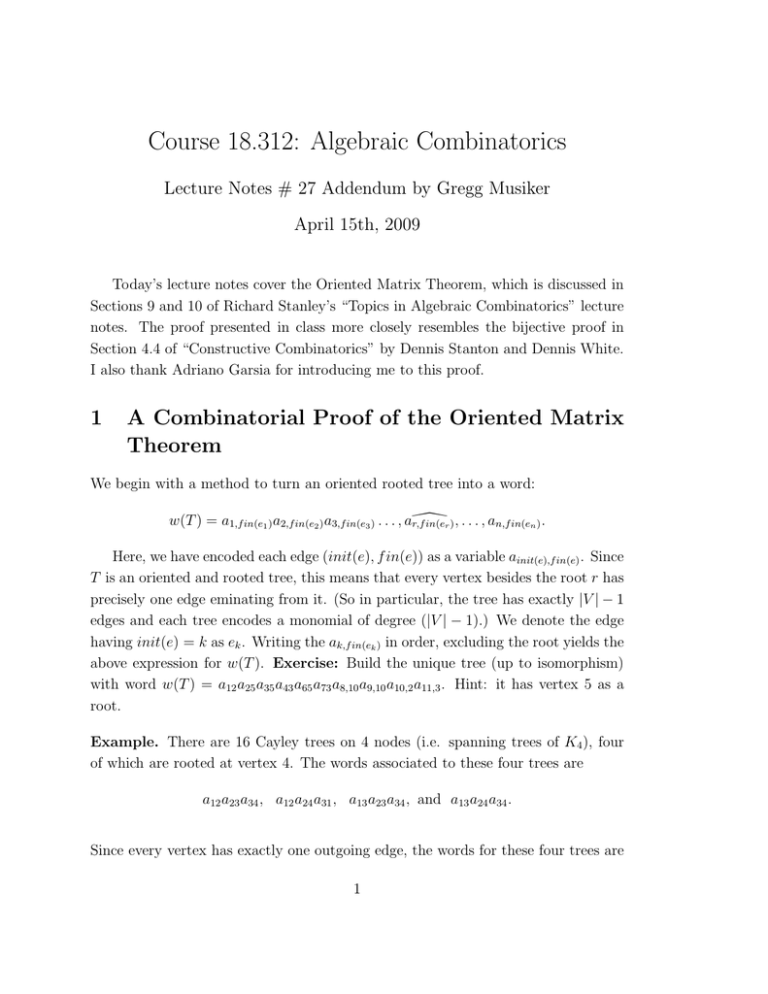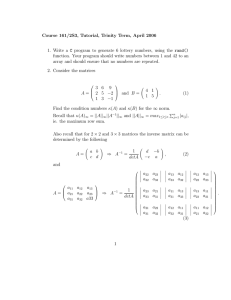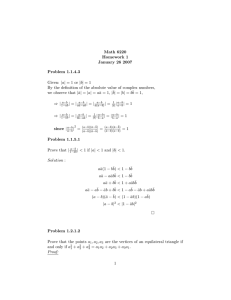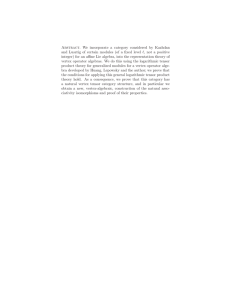Course 18.312: Algebraic Combinatorics April 15th, 2009
advertisement

Course 18.312: Algebraic Combinatorics
Lecture Notes # 27 Addendum by Gregg Musiker
April 15th, 2009
Today’s lecture notes cover the Oriented Matrix Theorem, which is discussed in
Sections 9 and 10 of Richard Stanley’s “Topics in Algebraic Combinatorics” lecture
notes. The proof presented in class more closely resembles the bijective proof in
Section 4.4 of “Constructive Combinatorics” by Dennis Stanton and Dennis White.
I also thank Adriano Garsia for introducing me to this proof.
1 A Combinatorial Proof of the Oriented Matrix
Theorem
We begin with a method to turn an oriented rooted tree into a word:
w(T ) = a1,f in(e1 ) a2,f in(e2 ) a3,f in(e3 ) . . . , a�
r,f in(er ) , . . . , an,f in(en ) .
Here, we have encoded each edge (init(e), f in(e)) as a variable ainit(e),f in(e) . Since
T is an oriented and rooted tree, this means that every vertex besides the root r has
precisely one edge eminating from it. (So in particular, the tree has exactly |V | − 1
edges and each tree encodes a monomial of degree (|V | − 1).) We denote the edge
having init(e) = k as ek . Writing the ak,f in(ek ) in order, excluding the root yields the
above expression for w(T ). Exercise: Build the unique tree (up to isomorphism)
with word w(T ) = a12 a25 a35 a43 a65 a73 a8,10 a9,10 a10,2 a11,3 . Hint: it has vertex 5 as a
root.
Example. There are 16 Cayley trees on 4 nodes (i.e. spanning trees of K4 ), four
of which are rooted at vertex 4. The words associated to these four trees are
a12 a23 a34 , a12 a24 a31 , a13 a23 a34 , and a13 a24 a34 .
Since every vertex has exactly one outgoing edge, the words for these four trees are
1
a subset of the monomials obtained by multiplying out the expression
(a12 + a13 + a14 )(a21 + a23 + a24 )(a31 + a32 + a34 ).
However, some of the resulting terms, such as a12 a23 a31 , do not correspond to trees,
but instead correspond to a digraph containing a cycle.
Theorem. For any complete graph Kn+1 , then the sum of all monomials corre­
sponding to oriented spanning trees of Kn+1 which are rooted at vertex (n + 1)
equals the determinant of the matrix L(Kn+1 ):
a12 + a13 + · · · + a1,n+1
−a12
−a13
...
−a21
a21 + a23 + · · · + a2,n+1
−a23
...
−a31
−a32
a31 + a32 + · · · + a3,n+1 . . .
..
..
..
..
.
.
.
.
−an1
−an2
−an3
. . . an1 + an2 + · · · + an,n+1
Note that this determinant can also be restated as the alternating sum
X
sgn(σ)b1,σ(1) b2,σ(2) · · · bn,σ(n)
σ∈Sn
where
(
ai1 + ai2 + · · · + ai,n+1 if i = j
bij =
−ai,j otherwise
.
Remark. This Theorem is equivalent to the oriented matrix tree theorem for a
general multigraph with directed edges. In particular, if one replaces each instance
of the variable aij with the number of directed edges from vertex i to vertex j (which
can possibly be zero) then the determinant of this matrix exactly equals the number
of oriented spanning trees rooted at vertex (n + 1).
We now work towards the proof of this theorem for the case of the digraph Kn+1 .
We first introudce the notation Ri = ai1 + ai2 + · · · + ai,n+1 , δi,j = 1 if i = j and 0
otherwise, and the convention that aii = 0 for all i. This allows us to rewrite the
above determinant as
n
XY
(Ri δi,σ(i) − ai,σ(i) )
σ∈Sn i=1
=
X
σ∈Sn
sgn(σ)
X
Y
S⊆{1,2,...,n} i∈S
(−ai,σ(i) )
Y
i∈{1,2,...,n}\S
Ri δi,σ(i) .
−a1n
−a2n
−a3n
..
.
Rearranging the sum, and letting S denote {1, 2 . . . , n} \ S, yields
X
X
Y
Y
Ri δi,σ(i)
det L(Kn+1 ) =
sgn(σ) (−ai,σ(i) )
S⊆{1,2,...,n} σ∈Sn
=
X
i∈S
X
i∈S
sgn(σ)(−1)|S|
Y
ai,σ(i)
i∈S
S⊆{1,2,...,n} σ∈Sn ,σ(i)=i for all i∈S
σ(i)6=i for any i∈S
Y
Ri .
i∈S
Note that this sum now involves only permutations σ with no fixed points in set S.
We call such a permutation a derangement on S and denote this set as D(S) for
Q
shorthand. We also let a(σ) be shorthand for i∈S ai,σ(i) .
Claim 1. The terms in the expansion of
maps from S to {1, 2, . . . , n + 1}.
Q
i∈S
Ri correspond to fixed-point-free
Proof. Each monomial in this expansion has the form ai1 ,j1 ai2 ,j2 · · · aik ,jk where
{i1 , i2 , . . . , ik } denotes the elements of S in order. Since we assume that ai,i = 0
for all i, the only terms appearing in this expansion are those where jd =
6 id for
all 1 ≤ d ≤ k. Since each id appears as the first index exactly once, we let this
monomial denote the function f such that f (id ) = jd for all 1 ≤ d ≤ k. Such an f
is therefore a fixed-point-free map with the correct domain and range.
Claim 2. The sums
X
X
X
(−1)#cycles
in σ
a(σ) a(f ),
(1)
S⊆{1,2,...,n} σ∈D(S) f is a fixed−point−free map : S→{1,2,...,n+1}
X
and
a(f ) (2)
f is a cycle free map : {1,2,...,n}→{1,2,...,n+1}
are equal.
We defer the proof of Claim 2 for the moment to observe that together Claims 1
and 2 imply the Oriented Matrix Tree Theorem.
Remark. By definition, sgn(σ) = (−1)(#cycles
in σ)−|S|
since σ(i) = i for all i ∈ S.
Q
It follows then by Claim 1, the notation a(f ) = i∈S ai,f (i) , and the definition
of D(S) that det L(Kn+1 ) equals the expression (1). Claim 2 then implies that
det L(Kn+1 ) also equals (2). Lastly, each cycle-free map f uniquely encodes an
oriented rooted spanning tree using a(f ) = w(T ), the word of the tree defined in
the introduction.
We have therefore reduced the proof to the verification of Claim 2. We proceed
using a technique known as a sign-reversing involution. This technique will be
used again in lectures 36 and 37 when we count non-intersecting lattice paths in
a directed acyclic graph (using Gessel-Viennot theory, also known as Lindström’s
Lemma).
Proof of Claim 2. The triple sum in expression (1) sums over the possible choices
of maps f : {1, 2, . . . , n} → {1, 2, . . . , n + 1} with no fixed points. The domain of
such a map can be broken up into two sets, S and S (with S possibly empty), so
that the restriction of f to S is a permutation σ with no fixed points, and the image
of f (S) is entirely contained in S.
Example: The reader may find it helpful to draw the digraph corresponding to the
word
a12 a24 a32 a47 a56 a65 a73 ,
and attempt to decompose this in at least one way into a disjoint set of digraphs
on S and S. Hint: For example, one may let S = {5, 6} so that a(σ) = a56 a65 ,
and a(f ) = a12 a24 a32 a47 a73 . Another decomposition would have S = {2, 3, 4, 5, 6, 7},
a(σ) = a24 a47 a73 a32 a56 a65 , and a(f ) = a12 .
By convention, we color the digraph on set S, corresponding to a(σ), red and the
digraph on set S, corresponding to a(f ), blue. Since f has no fixed points, it follows
that if set S is non-empty, then it contains at least two elements and the digraph
corresponding to the restriction f |S contains at least one cycle. Thus the red
digraph contains at least one cycle unless S is empty.
We define a map on the space of these bicolored digraphs that takes the cycle contain­
ing the vertex with the lowest index (with respect to the ordering {1, 2, 3 . . . , n + 1})
and switches the color of this cycle. Observe that changing this color still results in
an (S, S)-decomposition, i.e. a (σ, f )-decomposition, that is still valid. The result­
ing word of this bicolored digraph is unchanged however the exponent of the sign
(−1)#cycles in σ is changed by precisely one since we only enumerate cycles in the set
S. Thus, in the total sum, these two words cancel out each other and the entire
sum reduces to the sum of contributions which do not pair-off in this way. This
results in only the fixed points, or the elements which are not changed by this map.
In this case, these terms exactly correspond to the blue acyclic digraphs, i.e. the
digraphs where S = ∅ and we obtain expression (2).
MIT OpenCourseWare
http://ocw.mit.edu
18.312 Algebraic Combinatorics
Spring 2009
For information about citing these materials or our Terms of Use, visit: http://ocw.mit.edu/terms.








